2019-01-17
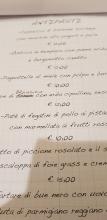 When I wrote about the "I Birbi" di Perugia, I complained that in a slowfood listed restaurant the first dish was flying in after 10 minutes, hardly enough to prepare it freshly. The "Maniinpasta" a Foligno I found through Google Maps. It is not slowfood listed, but it took them 45 minutes to bring the first course. A more than reasonable time to prepare "petto di piccione arosolato con il suo patè ed una trancia di foie gras e crema di mele". Finally an Italian Chef who prepares pigeon (red meat!) al sangue. I enjoyed the tender and juicy breast of the bird. The patè contributed flavor, the fois gras fat. The apple cream was nicely refreshing. No mg of salt too much! Only some grains beside the food, wonderful!
When I wrote about the "I Birbi" di Perugia, I complained that in a slowfood listed restaurant the first dish was flying in after 10 minutes, hardly enough to prepare it freshly. The "Maniinpasta" a Foligno I found through Google Maps. It is not slowfood listed, but it took them 45 minutes to bring the first course. A more than reasonable time to prepare "petto di piccione arosolato con il suo patè ed una trancia di foie gras e crema di mele". Finally an Italian Chef who prepares pigeon (red meat!) al sangue. I enjoyed the tender and juicy breast of the bird. The patè contributed flavor, the fois gras fat. The apple cream was nicely refreshing. No mg of salt too much! Only some grains beside the food, wonderful!2019-01-14
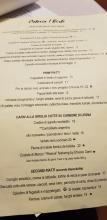 During my birthday Umbria trip I wanted to try a Restaurant Perugia, but I had mixed up opening days. It was Sunday and all my 3 choices were closed. In desperation I went back to Google "Slowfood Perugia". Something came out. Osteria "I Birbi" , just around the corner from the wonderful rundown, but classy Hotel Iris, where I was lodging.
During my birthday Umbria trip I wanted to try a Restaurant Perugia, but I had mixed up opening days. It was Sunday and all my 3 choices were closed. In desperation I went back to Google "Slowfood Perugia". Something came out. Osteria "I Birbi" , just around the corner from the wonderful rundown, but classy Hotel Iris, where I was lodging.2018-12-05
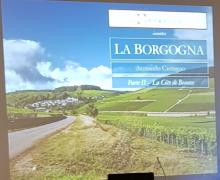 I am without any knowledge about French wines and still more about Burgundy wines. So I took the opportunity to participation with tasting organized by Intrecci (Famiglia Cotarella) in Castiglione. I participated in the second Masterclass give by Armando Castagno, who really knows everything about Burgundy wines and has written a book about it.
I am without any knowledge about French wines and still more about Burgundy wines. So I took the opportunity to participation with tasting organized by Intrecci (Famiglia Cotarella) in Castiglione. I participated in the second Masterclass give by Armando Castagno, who really knows everything about Burgundy wines and has written a book about it.2018-11-29
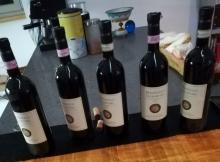 WineSong Orvieto organized a vertical tasting of Sagrantino from Scacciadiavoli. Local producers and wine professionals tasted Sagrantino vintages from 2008 to 2012 with specifically paired dishes.
All vintages were excellent. Most participants favoured the 2011, 2 the 2009 vintage.
WineSong Orvieto organized a vertical tasting of Sagrantino from Scacciadiavoli. Local producers and wine professionals tasted Sagrantino vintages from 2008 to 2012 with specifically paired dishes.
All vintages were excellent. Most participants favoured the 2011, 2 the 2009 vintage.
2018-11-26
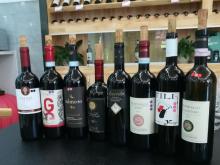 On November 16, Winetasting at "11Roads" company in Guangzhou. 20 participants, 12 wines, 11 from Umbria and 1 Lambrusco. China is still a red wine country, but there was interest for the whites from some participants
On November 16, Winetasting at "11Roads" company in Guangzhou. 20 participants, 12 wines, 11 from Umbria and 1 Lambrusco. China is still a red wine country, but there was interest for the whites from some participants
2018-10-30
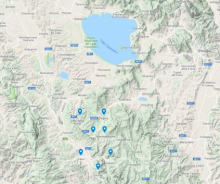 As in nearly any cultivation we observe a reduction in biodiversity in vineyards. In the second half of the 19th century, most European vineyards have been destroyed by phylloxera, a parasite, which came from North America. After this vineyards were replanted with the american "Vitis" resistant to the parasite. But many old grape types got lost. This loss of diversity was increased by the change of wine production (to specialized grapes) in the last 30 years.
Defending biodiversity is important! for having fun and many different wines. But also to increase resilience against pests or climatic change. The project "viti vicciute"collected grape samples from wild or abandoned grape stocks in 8 municipalities in the North of Orvieto with the participation 10 wineries.
As in nearly any cultivation we observe a reduction in biodiversity in vineyards. In the second half of the 19th century, most European vineyards have been destroyed by phylloxera, a parasite, which came from North America. After this vineyards were replanted with the american "Vitis" resistant to the parasite. But many old grape types got lost. This loss of diversity was increased by the change of wine production (to specialized grapes) in the last 30 years.
Defending biodiversity is important! for having fun and many different wines. But also to increase resilience against pests or climatic change. The project "viti vicciute"collected grape samples from wild or abandoned grape stocks in 8 municipalities in the North of Orvieto with the participation 10 wineries.2018-10-26
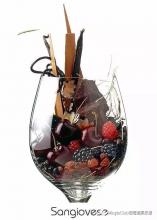 Nixy MingleClub葡萄酒俱乐部 4月24日
Sangiovese on the vine
Sangiovese-Sangiovese is named "Sanguis Jovis" and in Latin means "Jupiter's Blood". Sangiovese is widely distributed in Italy, especially in the central “red belt” area. "Red belt" refers to several regions in central Italy: Umbria, Lazio, Tuscany, Marche and other regions. These large regions have long been controlled by the Communist Party of Italy, and are still the areas that favor the left-liberal position, and the wines produced are also particularly famous. The most famous of them, Chianti, Brunello and Vino Nobile di Montepulciano, are made from Sangiovese grapes.
Italy produces Sangiovese wine producing regions
Nixy MingleClub葡萄酒俱乐部 4月24日
Sangiovese on the vine
Sangiovese-Sangiovese is named "Sanguis Jovis" and in Latin means "Jupiter's Blood". Sangiovese is widely distributed in Italy, especially in the central “red belt” area. "Red belt" refers to several regions in central Italy: Umbria, Lazio, Tuscany, Marche and other regions. These large regions have long been controlled by the Communist Party of Italy, and are still the areas that favor the left-liberal position, and the wines produced are also particularly famous. The most famous of them, Chianti, Brunello and Vino Nobile di Montepulciano, are made from Sangiovese grapes.
Italy produces Sangiovese wine producing regions2018-10-23
 Nixy汪纯 MingleClub葡萄酒俱乐部 4月24日
In the Middle Ages, the various lords were calling and playing all the year round. Therefore, the people of the Middle Ages must first find a mountain, build a well, build at least a castle, and then slowly build a city, so each lord in the Middle Ages has many castles.
Nixy汪纯 MingleClub葡萄酒俱乐部 4月24日
In the Middle Ages, the various lords were calling and playing all the year round. Therefore, the people of the Middle Ages must first find a mountain, build a well, build at least a castle, and then slowly build a city, so each lord in the Middle Ages has many castles.
 When I wrote about the "I Birbi" di Perugia, I complained that in a slowfood listed restaurant the first dish was flying in after 10 minutes, hardly enough to prepare it freshly. The "Maniinpasta" a Foligno I found through Google Maps. It is not slowfood listed, but it took them 45 minutes to bring the first course. A more than reasonable time to prepare "petto di piccione arosolato con il suo patè ed una trancia di foie gras e crema di mele". Finally an Italian Chef who prepares pigeon (red meat!) al sangue. I enjoyed the tender and juicy breast of the bird. The patè contributed flavor, the fois gras fat. The apple cream was nicely refreshing. No mg of salt too much! Only some grains beside the food, wonderful!
When I wrote about the "I Birbi" di Perugia, I complained that in a slowfood listed restaurant the first dish was flying in after 10 minutes, hardly enough to prepare it freshly. The "Maniinpasta" a Foligno I found through Google Maps. It is not slowfood listed, but it took them 45 minutes to bring the first course. A more than reasonable time to prepare "petto di piccione arosolato con il suo patè ed una trancia di foie gras e crema di mele". Finally an Italian Chef who prepares pigeon (red meat!) al sangue. I enjoyed the tender and juicy breast of the bird. The patè contributed flavor, the fois gras fat. The apple cream was nicely refreshing. No mg of salt too much! Only some grains beside the food, wonderful! During my birthday Umbria trip I wanted to try a Restaurant Perugia, but I had mixed up opening days. It was Sunday and all my 3 choices were closed. In desperation I went back to Google "Slowfood Perugia". Something came out. Osteria "I Birbi" , just around the corner from the wonderful rundown, but classy Hotel Iris, where I was lodging.
During my birthday Umbria trip I wanted to try a Restaurant Perugia, but I had mixed up opening days. It was Sunday and all my 3 choices were closed. In desperation I went back to Google "Slowfood Perugia". Something came out. Osteria "I Birbi" , just around the corner from the wonderful rundown, but classy Hotel Iris, where I was lodging. I am without any knowledge about French wines and still more about Burgundy wines. So I took the opportunity to participation with tasting organized by Intrecci (Famiglia Cotarella) in Castiglione. I participated in the second Masterclass give by Armando Castagno, who really knows everything about Burgundy wines and has written a book about it.
I am without any knowledge about French wines and still more about Burgundy wines. So I took the opportunity to participation with tasting organized by Intrecci (Famiglia Cotarella) in Castiglione. I participated in the second Masterclass give by Armando Castagno, who really knows everything about Burgundy wines and has written a book about it. WineSong Orvieto organized a vertical tasting of Sagrantino from Scacciadiavoli. Local producers and wine professionals tasted Sagrantino vintages from 2008 to 2012 with specifically paired dishes.
All vintages were excellent. Most participants favoured the 2011, 2 the 2009 vintage.
WineSong Orvieto organized a vertical tasting of Sagrantino from Scacciadiavoli. Local producers and wine professionals tasted Sagrantino vintages from 2008 to 2012 with specifically paired dishes.
All vintages were excellent. Most participants favoured the 2011, 2 the 2009 vintage.
 On November 16, Winetasting at "11Roads" company in Guangzhou. 20 participants, 12 wines, 11 from Umbria and 1 Lambrusco. China is still a red wine country, but there was interest for the whites from some participants
On November 16, Winetasting at "11Roads" company in Guangzhou. 20 participants, 12 wines, 11 from Umbria and 1 Lambrusco. China is still a red wine country, but there was interest for the whites from some participants
As in nearly any cultivation we observe a reduction in biodiversity in vineyards. In the second half of the 19th century, most European vineyards have been destroyed by phylloxera, a parasite, which came from North America. After this vineyards were replanted with the american "Vitis" resistant to the parasite. But many old grape types got lost. This loss of diversity was increased by the change of wine production (to specialized grapes) in the last 30 years. Defending biodiversity is important! for having fun and many different wines. But also to increase resilience against pests or climatic change. The project "viti vicciute"collected grape samples from wild or abandoned grape stocks in 8 municipalities in the North of Orvieto with the participation 10 wineries.
 Nixy MingleClub葡萄酒俱乐部 4月24日
Sangiovese on the vine
Sangiovese-Sangiovese is named "Sanguis Jovis" and in Latin means "Jupiter's Blood". Sangiovese is widely distributed in Italy, especially in the central “red belt” area. "Red belt" refers to several regions in central Italy: Umbria, Lazio, Tuscany, Marche and other regions. These large regions have long been controlled by the Communist Party of Italy, and are still the areas that favor the left-liberal position, and the wines produced are also particularly famous. The most famous of them, Chianti, Brunello and Vino Nobile di Montepulciano, are made from Sangiovese grapes.
Italy produces Sangiovese wine producing regions
Nixy MingleClub葡萄酒俱乐部 4月24日
Sangiovese on the vine
Sangiovese-Sangiovese is named "Sanguis Jovis" and in Latin means "Jupiter's Blood". Sangiovese is widely distributed in Italy, especially in the central “red belt” area. "Red belt" refers to several regions in central Italy: Umbria, Lazio, Tuscany, Marche and other regions. These large regions have long been controlled by the Communist Party of Italy, and are still the areas that favor the left-liberal position, and the wines produced are also particularly famous. The most famous of them, Chianti, Brunello and Vino Nobile di Montepulciano, are made from Sangiovese grapes.
Italy produces Sangiovese wine producing regions Nixy汪纯 MingleClub葡萄酒俱乐部 4月24日
In the Middle Ages, the various lords were calling and playing all the year round. Therefore, the people of the Middle Ages must first find a mountain, build a well, build at least a castle, and then slowly build a city, so each lord in the Middle Ages has many castles.
Nixy汪纯 MingleClub葡萄酒俱乐部 4月24日
In the Middle Ages, the various lords were calling and playing all the year round. Therefore, the people of the Middle Ages must first find a mountain, build a well, build at least a castle, and then slowly build a city, so each lord in the Middle Ages has many castles.